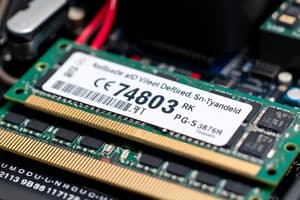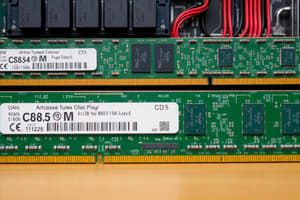Podcast
Questions and Answers
What is the primary function of primary storage?
What is the primary function of primary storage?
- Backing up data in case of power failure
- Temporary storage for data and program instructions (correct)
- Storing operating system files
- Long-term storage of data and programs
What is a characteristic of secondary storage?
What is a characteristic of secondary storage?
- Fast access times, allowing for quick data retrieval
- Non-volatile, meaning data is retained even when power is turned off (correct)
- Limited capacity, typically ranging from a few GB to several dozen GB
- Volatile, meaning data is lost when power is turned off
What is an example of primary storage?
What is an example of primary storage?
- Solid-State Drive (SSD)
- Hard Disk Drive (HDD)
- Random Access Memory (RAM) (correct)
- Optical Drive (CD, DVD, Blu-ray)
What is a characteristic of primary storage?
What is a characteristic of primary storage?
What is an example of secondary storage?
What is an example of secondary storage?
What is the primary difference between primary and secondary storage?
What is the primary difference between primary and secondary storage?
What is a characteristic of secondary storage?
What is a characteristic of secondary storage?
What is the typical capacity of primary storage?
What is the typical capacity of primary storage?
Flashcards are hidden until you start studying
Study Notes
Primary Storage
- Also known as main memory or RAM (Random Access Memory)
- Temporary storage for data and program instructions that the CPU uses while running applications
- Volatile, meaning data is lost when power is turned off
- Data is stored in a volatile state, meaning it can be changed or written
- Fast access times, allowing for quick data retrieval and processing
- Limited capacity, typically ranging from a few gigabytes to several dozen gigabytes
Characteristics of Primary Storage
- Volatile: Data is lost when power is turned off
- Volatile state: Data can be changed or written
- Fast access: Quick data retrieval and processing
- Limited capacity: Typically ranging from a few GB to several dozen GB
Secondary Storage
- Also known as auxiliary storage or non-volatile memory
- Long-term storage for data and programs, even when power is turned off
- Non-volatile, meaning data is retained even when power is turned off
- Data is stored in a non-volatile state, meaning it cannot be changed or written
- Slower access times compared to primary storage
- Higher capacity, ranging from hundreds of gigabytes to several terabytes
Characteristics of Secondary Storage
- Non-volatile: Data is retained even when power is turned off
- Non-volatile state: Data cannot be changed or written
- Slower access: Slower data retrieval and processing compared to primary storage
- Higher capacity: Ranging from hundreds of GB to several TB
Examples of Secondary Storage
- Hard Disk Drives (HDD)
- Solid-State Drives (SSD)
- Flash Drives
- Optical Drives (CD, DVD, Blu-ray)
- Magnetic Tapes
- External Hard Drives
Primary Storage
- Main memory or RAM (Random Access Memory) provides temporary storage for data and program instructions while running applications.
- Data is lost when power is turned off due to its volatile nature.
- Data can be changed or written in primary storage due to its volatile state.
- Primary storage offers fast access times, enabling quick data retrieval and processing.
- Capacity is limited, typically ranging from a few gigabytes to several dozen gigabytes.
Secondary Storage
- Auxiliary storage or non-volatile memory provides long-term storage for data and programs, even when power is turned off.
- Data is retained even when power is turned off due to its non-volatile nature.
- Data cannot be changed or written in secondary storage due to its non-volatile state.
- Secondary storage offers slower access times compared to primary storage.
- Capacity is higher, ranging from hundreds of gigabytes to several terabytes.
Examples of Secondary Storage
- Hard Disk Drives (HDD) are a type of secondary storage.
- Solid-State Drives (SSD) are a type of secondary storage.
- Flash Drives are a type of secondary storage.
- Optical Drives (CD, DVD, Blu-ray) are a type of secondary storage.
- Magnetic Tapes are a type of secondary storage.
- External Hard Drives are a type of secondary storage.
Studying That Suits You
Use AI to generate personalized quizzes and flashcards to suit your learning preferences.




